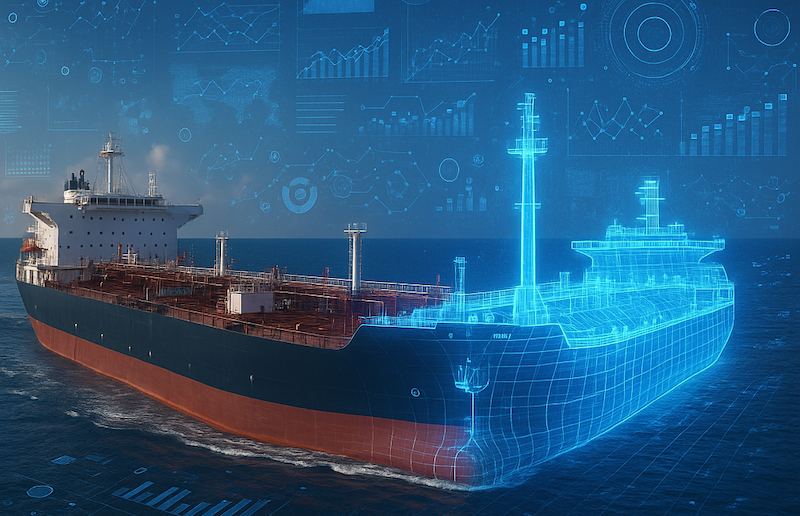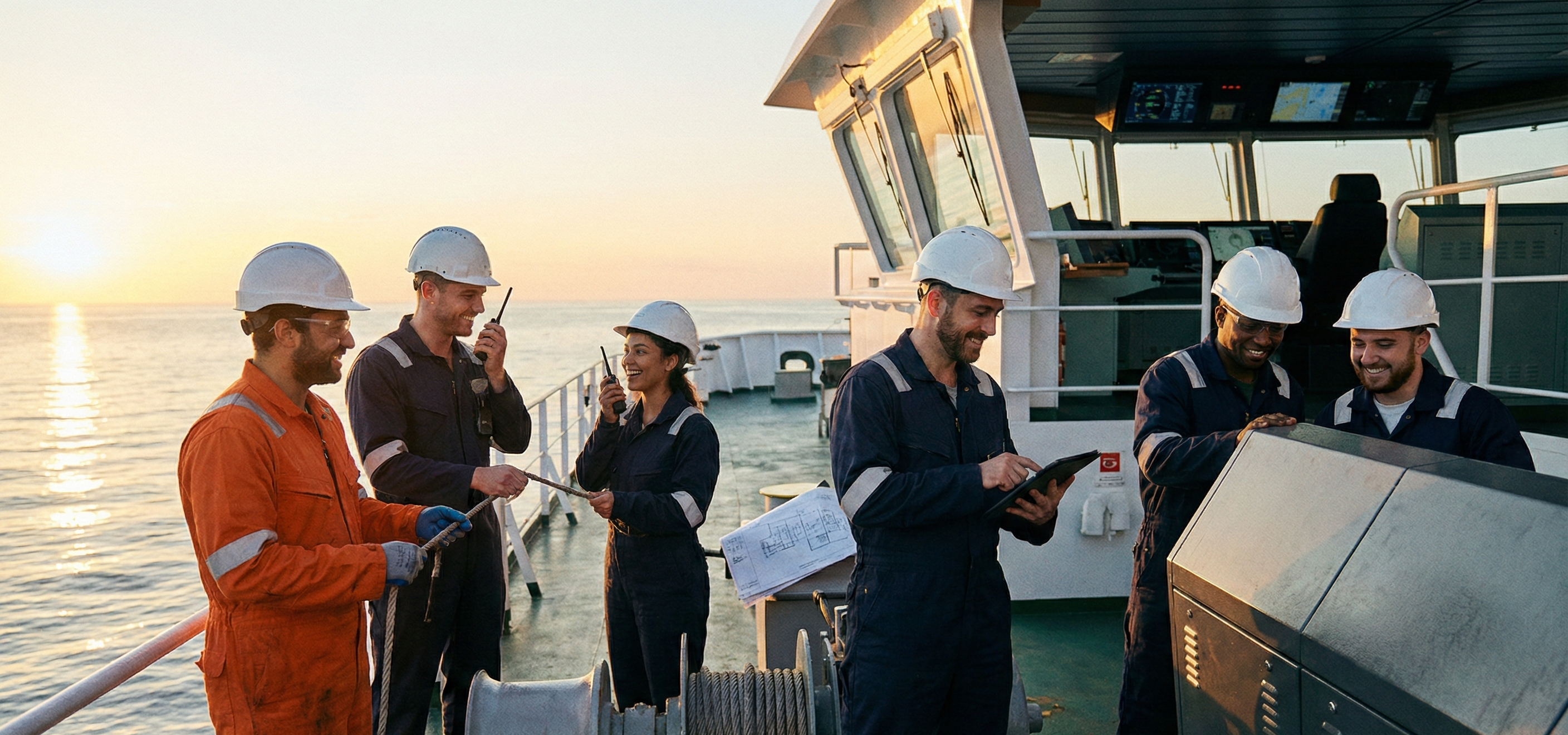Thanks to the rising prominence of artificial intelligence, IoT and cloud computing, the maritime industry is entering a new phase of digitalization. Perhaps the most holistic use of these innovative technologies – and others – is achieved within a conceptual model called ‘Digital Twin’, which simulates real environments within a digital framework that delivers accurate real-time monitoring enhanced with predictive capabilities and optimization recommendations.
What Is a Digital Twin?
A digital twin is a high-fidelity duplication of a physical entity, which is destined to morph into a robust framework that simulates a dynamic real-world environment. Digital twins are connected to physical entities via a network of live data-generating sensors and software components.
Yet digital twins differ from other simulations in that they are dynamic rather than static, as their ability to evolve in real-time is always in tune with the vessel’s true conditions and the behaviors of its components. Instead of pre-programmed scenarios that are commonplace in simulators, digital twins are continuously updated with real-world data. Instead of focusing on single scenarios, as is the case with many simulators, digital twins are able to mirror complex, multi-variable systems and use sensor networks to integrate external conditions.
In the case of maritime shipping, the most common digital twin is a digital model that mirrors the behavior and performance of a real-life vessel. Constantly analyzed by experts, digital twins allow stakeholders to review a wide variety of performance parameters – engine performance, fuel consumption, hull health, sustainability measures, energy use and more – with ease. More importantly, operators can conduct risk-free alternations within the digital twin environment in order to examine potential improvements in ship performance.
Ships are not the only maritime assets that lend themselves to digital twinning. Aside from ship twins, ports can also be twinned, simulating activities such as cargo docking and release, ship berths, equipment performance and more. In fact, digital twin models are already assisting ports around the world in addressing challenges that cause frequent delays and increase costs. By analyzing digital port environments that replicate actual ports, operators can not only become more efficient in real-time, but also predict future bottlenecks and take action to avoid them.
By creating digital twins for many or all vessels, entire fleets can also deploy large-scale twinning. After creating a digital twin for each ship in the fleet, fleets are able to establish a vast network that connects all vessels, facilitating a wide variety of data-based analytics, from real-time comparisons between ships to wide-level monitoring at sea.
Digital Twins at Sea: The Main Benefits
A wealth of benefits can be generated by employing a digital twin in maritime operations. Here are some of the most prominent and easily attainable advantages:
- Real-time operational awareness: A ship’s digital twin can alert operators in an instant to a variety of scenarios above and below deck, that the crew may not be aware of. The biggest impact of this heightened awareness is better decision support for the crew and other stakeholders, regarding navigation, maneuvering, speed, maintenance and more.
Predictive maintenance: By picking up on engine and equipment issues due to sensors and sensitive IoT technology, digital twins can help vessels and even entire fleets reduce downtime and avert unnecessary costs.
- Energy and emissions optimization: Digital twins are helpful in measuring and monitoring energy consumption and carbon emissions. With the help of predictive AI, which has access to the data and fits in seamlessly within the digital twin environment, vessels can generate relevant recommendations that pinpoint areas in which less energy can be utilized during their respective voyages.
- Enhanced training environments: By immersing themselves in digital environments, vessel crews and port personnel can use digital twin-based training to simulate, practice and solve countless real scenarios – absolutely risk-free. Naturally, the diversity of scenario simulations provided to the crews is unique to digital twins, and is not available in most simulators.
- Ship design and retrofitting: Ship designers and builders can use digital twin models to analyze and compare design choice decisions – as well as their projected impact throughout the ship’s lifecycle – without lifting a single drill bolt or ordering a chunk of steel.
- Crew safety: With their real-time hazard prediction and response guidance capabilities, digital twins help enforce crew safety. Live data projected from vast sensor networks protect crews by enhancing situational awareness and collision avoidance, while scenario-based training prepares them for a variety of high-risk situations. Last but certainly not least, digital twins ensure SOLAS, ISM and ISPS safety code compliance, which further reduces the chance for unforeseen safety occurrences.
AI in Maritime and the Digital Twin Connection
AI systems can integrate seamlessly within digital twin environments, adding valuable layers of significance that can greatly increase vessel and fleet ROI.
For starters, AI systems are data-driven in nature – a characteristic that perfectly complements the vast swaths of data delivered by digital twin models. AI ingests data, analyzing and interpreting raw information to locate specific patterns and generate predictive insights that improve ship voyage. With data generated by digital twins, AI can forecast certain system failures, alongside other conditions that impact voyage efficiency.
Anomaly detection is another one of maritime AI’s key strengths. Relying on digital twin data, AI systems can identify operational deviations in real-time, from unexpected engine performance and unusual fuel consumption to alterations from standard operating procedures and misalignment with maritime regulations. After such detections are made, AI systems can generate accurate suggestions to make instant adjustments that effectively address these anomalies.
AI systems can also add layers of data to the digital model itself. For example, AI-based situational awareness systems such as Orca AI’s SeaPod generate visual data via advanced computer vision capabilities, which can be integrated into the digital twin environment and paint a more robust picture in terms of analysis, classification, comparison and prediction.
Creating Maritime Digital Twins: The Main Challenges
Like all innovative technology, digital twins pose certain challenges for implementors across the maritime industry. By overcoming these challenges, the industry will further assist its evolution in terms of technology-assisted efficiency:
- Data standardization: To be truly effective, digital twin models must be based on robust, high-quality data. Yet this requires top-level sensor and communication infrastructure – which not all vessels and fleets have. This can lead to different fleets exhibiting, reporting and publishing drastically different data sets that support different outcomes – leading to industry confusion.
- Connectivity: Without a strong and reliable bandwidth that can remain stable even when the ship is miles from shore, real-time digital twins will experience communication lags, not update in time and falter during the most important junctures.
- Human adoption: Like AI, digital twins require human trust and usability to be effective. Yet some indications reveal that in certain cases, crews and personnel are reluctant to rely on digital twin models to decipher ship and port scenarios, reverting to more familiar methods.
- High costs: Encompassing sensors, cloud infrastructure and dedicated personnel, Digital twin modeling often requires a high financial investment, which may be difficult to secure without ROI certainty. Not all fleets have the currency needed to support digital twin operations, especially at the early stages.
Developing a Digital Twin: The Basic Requirements
Digital twin environments encompass an intricate maze of components. Here are the fundamentals that are absolutely essential for ship digital twin success:
- Sensor infrastructure onboard the ship and at port is absolutely crucial for data generation. Consider this the very backbone of the digital twin. The sensor suite included motion sensors and smart cameras that measure everything from engine propulsion, ship navigation and vessel velocity to environmental impact and structural integrity.
- High-bandwidth connectivity transports the data in real-time, from physical vessels at sea to the operators’ screens. Thankfully, maritime connectivity is supplemented by satellite technology delivered by reliable Starlink and Inmarsat solutions, among others.
- Cloud computing infrastructure enables digital twin frameworks to store vast amounts of data and scale ambitiously, according to specific needs. Furthermore, cloud computing provides designated personnel with easy access to said data.
- Simulation platforms: If sensors are the backbone of the digital twin, then simulation platforms are the brains. Equipped with AI/Machine Learning integration capabilities, simulation platforms adapt to dynamic conditions and produce data-driven predictions.
- Regulation compliance: From safety guidelines to environmental requirements, digital twin activities must be aware of and fully adhere to maritime regulations developed by IMO, IACS and other governing entities,while complying with technical standards developed by different classification societies. In fact, the very concept of digital twin monitoring is designated to assist vessels in their regulation compliance efforts.
What about ROI?
In the end, the main aspect driving digital twin adoption – in maritime and other industries – is expected ROI. Demanding a significant investment from fleets in terms of technological implementation, digital twin technology promises to deliver a significant return-on-investment, in more ways than one.
- Fuel and energy efficiency gains due to thorough data analysis and recommendations that lead to optimized, more cost-effective and eco-friendly operations. Digital twin data also helps ships keep in line with environmental regulations and avoid costly fines.
- Early detection of potential malfunctions can lead to fewer unplanned maintenance events and down-time scenarios that delay voyage timelines and increase costs due to delays and repairs.
- Extended operational life of a diverse collection of maritime assets, from ship engines to hull components. Due to data collection and insights, the ship’s crew can actively pursue preventative measures against corrosion and other forms of structural wear and tear.
- Port operation efficiencies that save time and money, including reduced traffic, lower turnaround times, better berth utilization, optimized cargo release, and more.
Pairing physical and digital for a promising future
Linked to ships, ports and entire fleets, AI-enhanced digital twins are gradually becoming a transformative force in today’s maritime industry. When backed by high-quality infrastructure, digital twins can prove themselves as assets both tactically and strategically, across vessel and port life cycles, in terms of operational and financial efficiency.
Yet similar to other groundbreaking technology, the successful industry-wide implementation of digital twin innovation rests not only on the shoulders of technology alone, but the appropriate regulations – and especially on human leadership and vision.








